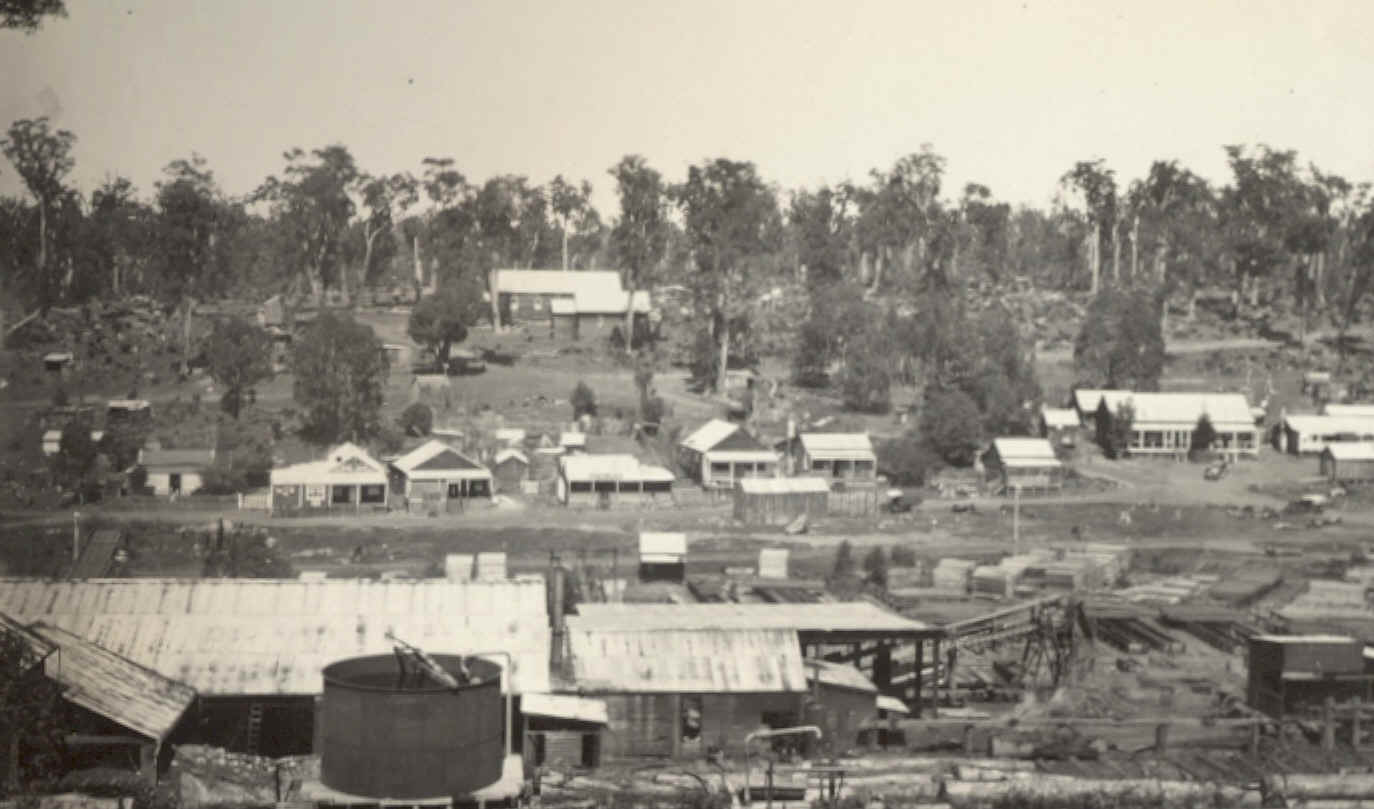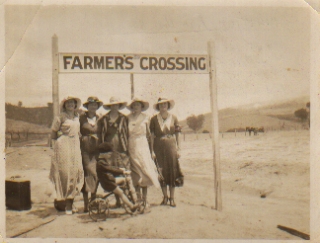The next station stop or siding heading east from
Dwellingup is :
Holyoake:
When the government opened the line to Dwellingup,
the Southwest Timbers Hewer Cooperative Society took up a concession at Holyoake
and had the railway line extended the 3 kilometres to the mill, which was opened
on 1st July 1910.
The Town was named after George Jacob Holyoake a
19th century champion of the cooperative cause in England. The
Government (State Saw Mills)brought the cooperative in January 1920. The
mill eventually closed in December 1958.
The Dwellingup bushfires of 1961 did
considerable damage to the townsite and it was never rebuilt.

Holyoak Mill and
townsite 1920's
|
Etmilyn:
Was a watering stop for locomotives travelling to
and from Narrogin.
Currently Etmilyn is the end of the Railway.
Negotiations are being made to restore / rebuild the railway as far as
Boddington.
Plavins:
In December 1918 Charles Plavin bought a mill from the Southwest Timber Hewers
Cooperative Society at 75 mile and 5 chain on the Hotham Valley line.
He built a bush railway and mill at the siding. He then
called his company the Australia Timber Company. He also held built another
siding further down the track which he called Hotham.
Inglehope:
Was a siding built by the WAGR for the crossing of trains. It
consisted of a small wooden hut where 'safe working' equipment was housed.
Amphion:
Was a siding where gravel was loaded (when required), for Ballast for the track.
A mill was later built there by the Public Works
Department (PWD), in 1913.
Chadora:
Another siding built by the WAGR for crossing of
trains, and stowage of wagons.
Pindalup:
A small mill was built close by.
Wuraming :
In 1913 the Public Works Department (PWD) needed supplies of sleepers for the
extensive program of Railway construction in progress throughout the southwest
of WA. At the same time they built a small
mill at Amphion. A town site was surveyed
and gazetted at the Wuraming Siding, but most of the community developed around
the mill about 6 Kilometres south of this site. In
November 1920 the mill was transferred to the State Saw Mills. (SSM).
Two railway lines converged at this point. The WAGR
line and the SSM line from Banksiadale to Hakea. The
Hakea mill closed in 1950's, so the line was rehabilitated in 1949/1950 to take
the bigger loads from the Asquith concession.
Hotham :
Charles Plavin (see Plavin siding) renamed his company, The Australian Lumber
Company (ALCO) which was incorporated on the 8th July 1920 and began operations
about November 1920 at Hotham. At first
horses were used until November 1922 on 9 Kilometres of track until a locomotive
was brought from WAGR on the 11th November 1922. ALCO
went into liquidation in March 1927. The
mill was closed and all stock sold bar one old steam locomotive, which was found
in 1993. (When found it was in very bad state of disrepair). The
Hotham Mill was a very isolated site until 1980 when gold mines were developed
nearby.
Tullis:
The Tullis Mill was built by Bunnings in 1936 to cut Jarrah timber. It
was built on private property belonging to F A & E Moos and Col Sinclair.
A 1.6 Kilometre railway connected the mill to the WAGR
at 91 Mile Siding (later named Westwood) which was actually 2.4 kilometres west
of Tullis Siding.
No bush lines were installed and the railway was
only used for transporting sawn timber. The
railway and mill closed in 1951. Two steam
locomotives were used on this line. One
locomotive, the Leonora was sold for scrap at Tullis in 1956.
Farmers Crossing:
Farmers Crossing was used as a wayside stop only (Put down and pick up goods).
No public roads have ever led to it, and it is believed to have been put in
place as an act of compensation to the Farmer family, part of whose property was
resumed for the railway when it came through. The
siding closed in 1958.
 |
Photo of Farmers
Crossing taken 1934. Pictured are members of the Farmer
family waiting for the train. Left to right. Gert Henrickson,
Martha Farmer, Pearl Milbourne, Eda Farmer, Gladys Farmer.
|
Boddington :
Boddington is named after Henry Boddington, a farmer who shepherded sheep in the
area in the 1860's and 1870's, and also leased land here in 1875. A pool in the
Hotham River was known as Boddington Pool, and when the site for a railway
stopping place and a townsite was chosen adjacent to the pool, Boddington was
selected as the name. The rise of the timber industry saw the construction of
the railway line from Dwellingup to Boddington that eventually linked with
Narrogin to the east. The townsite was gazetted in 1912.
Negotiations are currently being made to restore /
rebuild the railway from Etmilyn Siding, as far as Boddington.
Click
here to travel beyond Boddington
Any
further Information or Photographs that relate to these places would be
gratefully appreciated - mail to : Webmaster
